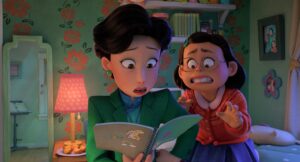“Turning Red,” a Pixar animated film released to Disney Plus on March 11, received a lot of criticism after people saw the trailers and other marketing materials. 
I went into my viewing experience sharing the same hesitations as other viewers: a girl turning into a red panda? Really? Is that the whole thing? Where is the Pixar creativity and emotional resonance we’ve all come to love?
Still, I tried to keep an open mind, and I was pleasantly surprised.
“Turning Red” follows 13 year old Mei Lee as she navigates middle school, deals with an overbearing mother, and gains the magical ability to turn into a red panda.
The red panda power is passed down through the women in her family. It tends to come out at unexpected times, like when Mei is feeling a strong emotion.
Her mother encourages her to keep the panda inside and continue being the well-behaved, straight-A student that Mei always has been.
However, her mother’s strict rules have made Mei feel isolated from her friends and peers. Instead of being able to go sing karaoke with her best friends, she has to come home immediately after school to help her mother run the family temple.
On the surface, this movie appears to be a poor metaphor for puberty and growing up. The marketing certainly didn’t help that image. However, the core of the film is the relationship between Mei and her mother.

Mei has to be a completely different person around her mother: quiet and reserved, instead of the boy-crazy, silly kid that she is.
As a person who grew up with strict parents and high expectations, I related to Mei a lot more than I thought I would. This movie portrays the feelings of isolation and frustration that being a 13 year old can bring.
The scene that hit me the hardest was toward the end, when Mei opened up to her mom. Mei tearfully admitted that she was scared that as she figured out who she was, it would damage her relationship with her mother.
And that is what the red panda represents: the parts of ourselves that we fear are unlovable, strange or just too much.
This movie argues that the opposite is the case. When we show the world who we truly are, we will find people who love us for it.
“Turning Red” shows tweendom in all its cringe-y, messy glory.
While different from its classic Pixar predecessors, “Turning Red” is a movie that many people, of many different ages, can relate to.

